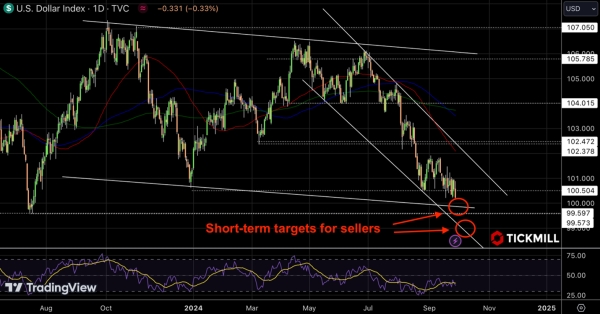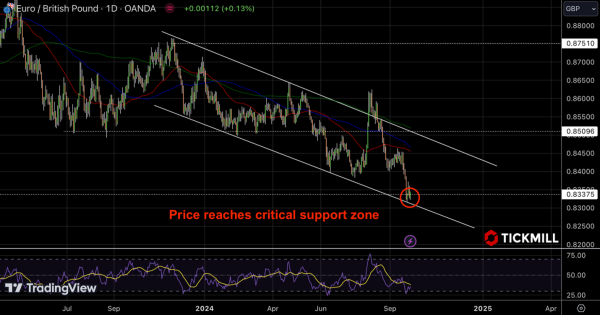US Dollar Under Pressure Amid Cooling Inflation
The USD experienced a decline following the latest PCE data—a key inflation gauge favored by the Federal Reserve. The annual PCE inflation rate slowed to 2.2%, down from 2.5% in July and below market expectations. Core inflation, excluding volatile food and energy prices, rose by 2.7% year-over-year, slightly higher than June's 2.6%.
Market participants are recalibrating their expectations for future Fed policy. Interest rate futures now indicate a higher probability of rate cuts in the November meeting. The debate centers on whether the Fed will opt for a 25 or 50 basis point reduction, reflecting growing concerns about economic growth and labor market softness.
The DXY, which measures the USD against a basket of six major currencies, has retreated to around 100.40, edging closer to a critical support level near 100.20. A decisive break below this support could signal further downside for the USD. Technical indicators suggest increased downside volatility ahead, especially if upcoming economic data reinforces the narrative of a slowing economy:

The coming week is packed with events that could influence the USD's trajectory. Fed Chair Jerome Powell's speech on Monday will be scrutinized for policy hints. Additionally, a slew of labor market reports, including non-farm payrolls and unemployment figures, will provide insights into the health of the job market. The ISM Purchasing Managers’ Index will also shed light on manufacturing activity. Given the Fed's data-dependent approach, these releases could significantly sway investor sentiment.
The Euro struggles to gain traction compared to its non-USD peers. Preliminary inflation data from France and Spain revealed that consumer prices are increasing at a slower pace than anticipated. The French CPI and Spain's HICP both undershot forecasts, signaling a broader easing of inflationary pressures within the Eurozone.
The softer inflation data has led to speculation that the European Central Bank (ECB) might reconsider its monetary tightening cycle. If the trend of slowing inflation persists, the ECB could contemplate cutting interest rates further to stimulate economic activity. Such a move would have significant implications for the EUR, potentially leading to further depreciation against other major currencies:

Investors should monitor the preliminary German HICP figures due on Monday, followed by Eurozone-wide data on Tuesday. Germany, being the largest economy in the Eurozone, plays a pivotal role in shaping ECB policy. Should German inflation align with the softer trends in France and Spain, it would add pressure on the ECB to adopt a more accommodative stance in its October meeting.